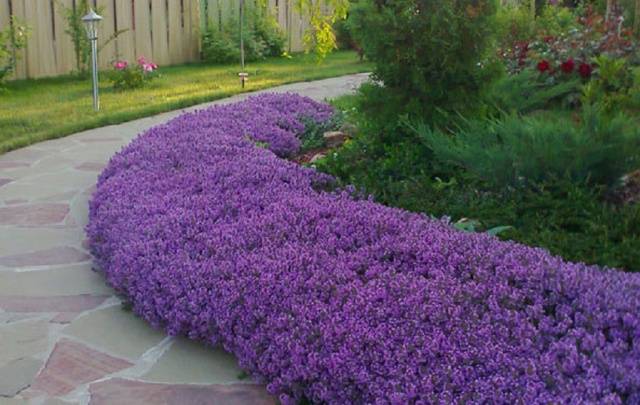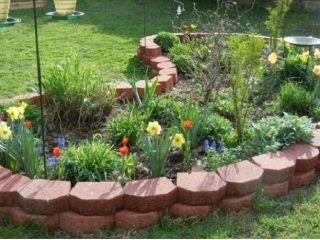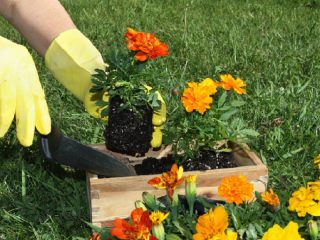Content
Border, frame, edging - any of these names are suitable for a clear boundary between two elements in landscape design, made with the help of plants or scrap materials.
It is not necessary to delimit the path and the flowerbed, mark a zone, or create a geometric line with tall plants. It is enough to use border perennials to get the desired result, as in the photo.
However, the attractiveness and functionality of an element can be achieved by following certain rules. After all, in addition to beauty and unusualness, a border of perennials should be practical and easy to care for.
This can be achieved by following the recommendations of landscape designers:
- plants are chosen in contrasting colors in relation to the other shades of the area that is framed;
- when determining boundaries, be sure to take into account the ability of border perennials to grow upward and expand (leave some room);
- plant border perennials closer to each other; you can get out of this situation by placing plants in two rows;
- choose unpretentious border perennials that look the same in any weather;
- adhere to the classic frame parameters (height 40 cm, height 50 cm);
- opt for slow-growing border perennials;
- select quickly recovering plants that can take on the desired shape after being damaged near the edge of paths or by a lawn mower.
Low-growing plants will help not only decorate borders for flower beds, but also to create a multi-tiered composition. Plants are divided into annuals and perennials. Border perennials include those in which only the above-ground part dies at the end of the season. The root system is preserved until spring and produces new shoots without additional insulation. The lifespan of border perennials is quite long. They bloom earlier than annuals and last longer with their attractive appearance.
Let's take a closer look at the group of border perennials
The biggest advantage of this type of plant is its low maintenance requirements. If they are planted correctly, then they do not need frequent watering and constant attention. The main concern should be given to the lighting requirements of plants. Some love the light and some prefer shade. By creating the best conditions for the plant, you ensure long-term decoration of the site in advance. Border perennials hide uneven soil better than other types and protect other plantings from the ubiquitous weed. In addition to light requirements, they differ in the height of adult plants by:
- short. Height does not exceed 30 cm.
- Medium height. The sizes of these species vary from 30 to 85 cm.
- Tall. They reach a height of up to 180 cm in adulthood.
In addition, there are climbing and groundcover border perennials.
All these species need to be planted in areas that are cleared of weeds.
How can you combine border perennials? Fences made from a mixture of different types look great. The only condition that must be met is the selection of plants with the same requirements for soil moisture, amount of light, and compatibility with other “neighbors.” It would be good if these were unpretentious species resistant to weather changes.
It depends on the preferences of the owner and compatibility with other decorative elements. Some deviation from generally accepted rules will add originality. You can simultaneously decorate the border with perennials of different heights and different shades.
Low-growing perennials Well suited for decorating borders along garden paths, along the edges of flower beds and ridges.
Medium height participate in tiered compositions and are used for planting as a separate element in plant fences.
Tall perennials will be useful during registration front garden border to divide the area into zones. Suitable for planting in the center of tiered compositions.
Curly used to decorate the perimeter of garden gazebos, terraces, and residential buildings. Climbing perennials look great on barrier structures, giving them a neat and attractive appearance.
Groundcover border perennials:
- copes well with weeds;
- protect the fertile layer of soil from being washed away by rain or blown away by winds;
- improve soil fertility;
- act as natural mulch;
- hide surface defects well;
- bloom throughout the season;
- grow quickly, creating a bright mat in the desired area.
Border perennials will require fertilizing taking into account the needs of each plant, careful loosening of the soil, and regular removal of diseased and dried out specimens.
Choosing plants for borders
Annual plants are very diverse, but their life span is very short. Therefore, by choosing border perennials, you will increase the lifespan and provide a clear line to your fence. Photos of plants can be a good help in making a quality choice. With their help, you will immediately decide which type is suitable for the intended border. Among the low-growing border perennials, the following should be highlighted:
Bluebell Carpathian
The height of an adult plant is 40 cm, the flowers are blue-violet with a diameter of 25 cm. It blooms from June to mid-September. Tolerates sunny areas and partial shade well. Demanding on soil fertility and drainage. Heavy soils with excess moisture and poor drainage may not allow plants to survive. With good soil preparation, it overwinters without problems; watering is necessary during prolonged drought and elevated air temperatures. To extend flowering time, be sure to regularly remove dried flowers. After flowering ends, the shoots are cut to 1/3 of the length. Fertilizing is carried out in early spring with nitrogen fertilizers and complex mineral fertilizers during the formation of buds. Border perennial propagates by cuttings (summer), seeds, and dividing bushes (spring or autumn).In addition to a full-fledged border, it can be used to decorate bright spots in a fence or for cutting.
Chives
A bulbous border perennial with a very high reproduction rate. By autumn, one bulb turns into a large bunch of chives. The originality of the plant lies in its nutritional value. Adapts perfectly to climatic conditions and performs decorative and nutritional functions at the same time. It does not require any care at all and is cold-resistant. Propagated by seeds, which are sown in April in rows at some distance from each other. Loves watering! Otherwise, the border perennial grows poorly and loses its attractiveness early. Feathers give bright colors in good lighting. These are the basic conditions for chives agricultural technology. May fall apart a bit if left large gap between plants.
Arabis (rezucha)
It can not only serve as a border perennial, but is also an excellent honey plant. This should be taken into account by summer residents who have bee colonies. Refers to ground cover rhizomatous perennial plants. The shoots take root easily when in contact with the ground. There are about a hundred species of Arabis. Depending on the variety and type, border perennials have varying degrees of winter hardiness. The most destructive thing for a plant is waterlogging of the soil or stagnation of water. Systematic pruning is required to improve flowering and haphazard spread of arabis throughout the site. The cut parts are used for vegetative propagation.
Carnation greyish-blue (caesius)
Blooms in the summer months. Light-loving, drought-resistant border flowers up to 15 cm high.It got its name because of the shade of the leaves, and the flowers of the carnation are bright purple. Does not require shelter for the winter. Forms dense leaf pads that beautifully frame the desired area.
To create a border, plants of different heights and sizes are suitable. Take a closer look at:
elegant dicenter,
blue hosta,
shade-tolerant astilbe
and gorgeous border roses.
Combination of perennials
How can you combine border perennials? The most popular varieties:
Plain border
Plants of the same color, but different or the same height, are suitable. This is at the request of the site owner. The tone can be harmonious or contrasting with other plants.
Variegated border
It's easy to create striped fencing or choose color-matching border perennials.
Conclusion
In any case, when planning design lines, you can give free rein to your creative imagination. A photo of ready-made combinations can lead to a completely unique idea that will decorate your garden.

























